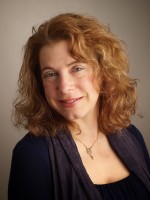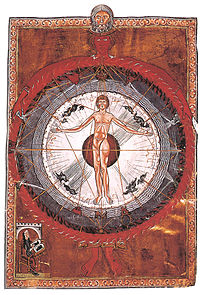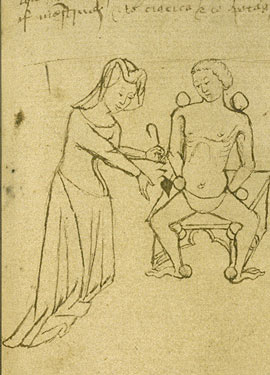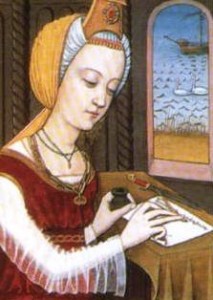 Saint Hildegard von Bingen (1098–1179) was not only a visionary Benedictine abbess, composer, and Powerfrau extraordinaire. She was also a physician and healer who developed her own highly original system of medical treatment and holistic dietary philosophy.
Saint Hildegard von Bingen (1098–1179) was not only a visionary Benedictine abbess, composer, and Powerfrau extraordinaire. She was also a physician and healer who developed her own highly original system of medical treatment and holistic dietary philosophy.
Saint Benedict of Nursia (480-543), the founder of her order, expressly forbade the study of medicine, which in his era derived solely from texts written by Pagans such as Hippocrates and Galen. Benedict believed that prayer alone must suffice in healing Christians.
But by Hildegard’s time, monasteries had become centers of healing that embraced the medical knowledge of both the Classical Pagan world and the pioneering work of Arab and Persian physicians. Nearly every monastic house had its own infirmary, hospice, apothecary, and medicinal garden. Hildegard would have had ample opportunity to train as a physician and apothecarer at Disibodenberg Monastery, a double monastery housing both monks and nuns, where she lived for most of the first half of her life.

Illumination based on Hildegard’s vision of the human body as the microcosm within the sacred macrocosm.
In his essay, “Hildegard’s Medicine: A Systematic Science of Medieval Europe,” Kevin Anthony Hay suggests that Hildegard trained as an infirmarer at Disibodenberg under the guidance of a senior monk before she later took charge of the infirmary. After she and her nuns left Disibodenberg to found their own community at Rupertsberg, she wrote Causae et Curae, her main medical text, possibly so that the new infirmarer at Disibodenberg could benefit from her knowledge and expertise. When designing the new abbey at Rupertsberg, Hildegard made sure to include a medicinal steambath. People throughout her region came to Rupertsberg to receive healing from her and her sisters.
In the Middle Ages, women freely practiced the medical arts. The School of Salerno, the first medieval European medical school and the epicenter of Western medical science, included both women instructors and students. One such instructor was the 11th century Trotula whose treatise on women’s health that bears her name, de Trotula, was used for centuries after her death. It was not until the mid-16th century that European women were formally forbidden to study and practice as physicians.
Hay believes Hildegard was unique among female practitioners of her time because her medicine didn’t focus solely on female complaints and also because she developed a systematic, scientific, and holistic understanding of medicine that rivaled what was coming out of Salerno, even though she had never received any formal university training.

A medieval woman physician treating a male patient
For Hildegard, medicine was an integral part of her religious vocation. Her medicine mirrored her theology—she believed that the human body was the microcosm within the sacred macrocosm of the universe and, as such, mirrored the splendor of creation. But if one fell into disharmony with the innate wholeness of creation, illness resulted. This could be treated through rest, herbal cures, steam baths, a proper diet, and by making one’s peace with the divine order.
She identified pre-cancerous states and developed herbal remedies to treat them before the cancer could develop. Naturopathic doctors in modern Germany still practice “Hildegard Medizin” and work with her dietary philosophy. She was a big fan of spelt bread.
If you are visiting Hildegard sites in Germany, be sure to stop at the Hildegard Forum, just across the Rhine from the Saint Hildegard Abbey in Eibingen. The Forum is run by religious sisters who offer outreach to the public to learn more about Hildegard, particularly her philosophy of holistic healing and nutrition. They manage a café and restaurant; offer seminars and retreats; and maintain an orchard and a medieval-style herb garden.
Mary Sharratt’s book Illuminations: A Novel of Hildegard von Bingen won the 2013 Nautilus Gold Award: Better Books for a Better World and was a 2012 Kirkus Book of the Year. Her forthcoming novel, The Dark Lady’s Mask, will be published by Houghton MIfflin Harcourt in Spring 2016. Visit her website.



I will be visiting Germany next year on my ancestor quest and I will put the Abbey among my destinations. It is near Darmstadt (Catherine Laddauer) and St. Nicholas Saarland (Heinrich Eiloff). Thanks for the suggestion.
I also note that Trotula and Hildegaard are both honored at the 13 central places in Judy Chicago’s Dinner Party.
https://www.brooklynmuseum.org/opencollection/objects/166082/Trotula_Place_Setting
http://www.brooklynmuseum.org/eascfa/dinner_party/place_settings/hildegarde_of_bingen.php
LikeLike
Carol, I hope you do enjoy your journey through Hildegard’s Rhineland. Lots of nice wine to sample, too! And thank you for the links to the Dinner Party. One day I need to get to Brooklyn and see it!
LikeLike
Thanks, Mary, it’s interesting that the medieval Hildegard confronts our era. Not that she remained hidden before that entirely, but only in the 20th century were her writings republished so extensively. She was a physician in many ways, including her deeply healing music. And the lyrics too so profoundly enjoyable in the context of modern eco-spirituality, and the healing of our planet — here, for instance, Hildegard’s magnificent celebration of the rebirth of spring, from the beginning of “O Frondens Virga” —
Hail, O greenest branch,
sprung forth in the airy breezes
of the prayers of the saints.
So the time has come
that your sprays have flourished:
hail, hail to you,
because the heat of the sun has exuded from you
like the aroma of balm.
LikeLike
Sarah, it is amazing how Hildegard seemed to spring back from obscurity in the 20th century, largely due to the scholarship of the nuns at the Saint Hildegard Abbey in Eibingen whose work laid the foundation for our modern Hildegard studies.
You’re so right about her music being as healing as her herbal remedies. I think it all fits together as one great mandala–her ethereal music which she viewed as the highest form of prayer, connecting the soul directly with the divine; her theology of immanence as well as transcendence; the wholesome diet and belief in the healing powers of the natural world; and the approach to health as realigning oneself as the harmonious microcosm within the vast, interconnected macrocosm.
LikeLike
Thanks for posting this. As you know, I’ve read Illuminations and loved it. I’ve been a fan of Hildegard’s since I first learned about her.
It’s good to know that women were physicians and honored as such before the medical “dark ages” when only men could be physicians and they mostly used astrology and leeches as their tools. Those physicians probably killed more people with their blood-letting than they healed. I’ve had a couple majorish surgeries and an almost-fatal asthma attack that kept me in the hospital for a week or so. I always made friends with my nurses and had fun telling them that we Ph.D.’s were scholars about 600 years before the barber-surgeons learned to wash their hands. This always gets a laugh from the nurses. Not so much the M.D.’s, though. One of my surgeons was an Asian-American woman. I liked her a lot.
LikeLike
Thank you so much for your comments, Barbara! The history of Western medicine is very eye-opening, indeed! I used to work in a physical therapy clinic and, ironically, many of the physicians I worked with were some of the unhealthiest people I knew. One was an unrepentent chain smoker who died in her 50s. It was heartbreaking because she knew exactly what she was doing to herself. On a lighter note, some naturopathic doctors in Germany are working with leeches again. Leeches are natural blood thinners, apparently!
LikeLike
Thanks so much for this article. I have been fascinated by Hildegard for several decades and find her music, her art, and her philosophies both intriguing and inspiring. One day I will visit her Abbey.
LikeLike
Thank you so much for commenting, Gongyla! I hope you do get to visit her abbey one day.
LikeLike
Merci, Mary. I have been giving “leçons” about ” “femmes de génie” (Hildegarde being one of them)
and your post is PARFAIT.
LikeLike
Thank you so much, Annie!
LikeLike
Thank you for your posts. There is more information on Hildegard von Bingen at HealthyHildegard.com
LikeLike